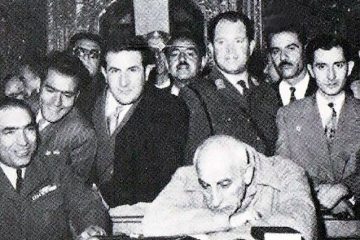Economic Terrorism Against Iran Nuclear Deal
Iran began its nuclear program in 1960 during the reign of Mohammad Reza Pahlavi. The inference of the country’s officials and managers for Iran to be present as a nuclear state at the time, and taking into consideration the elimination of oil resources in the distant future and Iran’s need to exploit nuclear energy, led to the implementation of a trade agreement with France within the same years.
After the revolution, the process of launching nuclear activities by Iran was pursued independently and without the need for other countries such as France. This process continued until on August 14, 2002, in the early years of Khatami’s second term, the People’s Mujahedin Organization, as one of the foreign oppositions of the Islamic Republic, notified the Atomic Energy Agency for the first time that there were secret nuclear activities in Natanz and Arak. This led to the opening of the Iran nuclear deal at the IAEA. After the Director General of the Atomic Energy Agency, Mohammad ElBaradei, visited our country’s nuclear facilities several times, he published the first report on Iran’s failure to implement the NPT. Following the official announcement of this report, Iran declared its readiness to cooperate with the IAEA in order to build trust, and in a meeting that the then-president, Mohammad Khatami, had with Mohammad ElBaradei, he said: “Since Iran itself is a victim of weapons of mass destruction, it does not seek nuclear weapons, and there is no room for weapons of mass destruction in its defense strategy. We seek to protect our national interests and security, but we ensure that we do not need nuclear weapons to achieve these goals. Since the allegations against Iran are not made with good intentions, whatever action Iran takes is still not a guarantee that no other excuses will be made to put pressure on Iran. The crime of the Islamic Republic of Iran is only that it has decided to be independent and to stand on its own two feet.” Although on August 25, 2003, Iran announced its full readiness for confidence-building negotiations with the IAEA, on September 12 of that year, the first resolution of the Board of Governors on Iran’s nuclear activities was signed at the suggestion of Germany, Britain, and France. On February 23, 2004, an agreement was signed under the title of the Brussels Agreement, according to which Iran undertakes to stop the testing and manufacturing of centrifuges required for enrichment, and in return, the European Union admits Iran to the World Trade Organization. From 2003 to 2005, several negotiations took place between Iran and the European and American parties in order to build trust in the Iran nuclear deal, but in the same years, we witnessed several resolutions against Iran led by the United States.
The United States’ Reasons for Blocking Iran’s Nuclear Activities
Multiple power resources in Iran’s structure, as well as the effects that these resources had on the expansion of regional power in Iran, had led to its consideration as a regional hegemony in the Middle East. Given the decline of the United States’ power in Iran after the withdrawal of its forces from its embassy, this matter went against the strategic policies of the United States, and for this reason, the US tried to control Iran’s rise to power.
The Role of American Think Tanks in Controlling Iran’s Power
Carnegie Think Tank (Carrot and Stick)
Each of the American think tanks has played a significant role in the decision-making of the American officials with regards to dealing with Iran. The common denominator of all these think tanks is the reduction of Iran’s regional hegemony, as well as rendering Iran’s actions as dependent on the United States in the international system.
The experience of disarming the former Republics of the Soviet in the form of loans for nuclear disarmament was one of the proposals of American think tanks. In this regard, George Perkovich, a senior expert at the Carnegie Endowment for International Peace, wrote in an article entitled “Changing Iran’s Nuclear Interests” that the United States should move toward effective incentives to bring about positive change in Iran. In this regard, a proposal package including four categories of human rights, Middle East peace, nuclear disarmament, and the prevention of an increase of power in the region, especially in Palestine and Lebanon, was proposed to the American officials by the Carnegie Think Tank. In return for these four categories, US officials can provide incentives such as the release of Iranian confiscated property in the United States, the gradual lifting of unilateral US sanctions, support for the Iran-Pakistan-India Peace Pipeline, and respect for Iran’s security and national sovereignty.
Brookings Institution (Negotiation for Negotiation)
Sir John Thomson, one of the leading researchers in American think tanks and also the United Kingdom Permanent Representative to the United Nations, in the final reports of the study projects on Iran nuclear deal, which was sent to the White House in March 2007, introduced controlling Iran’s nuclear power at a minimal cost as the main US strategy. In this regard, it was suggested that Iran gets encouraged to negotiate on the demands of the United States of America and that a step-by-step process gets implemented in putting into effect these demands, ranging from the nuclear deal to the field of human rights and so on.
US Council on Foreign Relations and the Carnegie Think Tank for International Peace (Expanding the Scope of Sanctions)
The US Council on Foreign Relations said that the only way to curb Iran’s behavior, especially in the area of missile weapons, was to increase the scope and depth of sanctions. Patrick Clawson, director of research at the Washington Institute for Near East Policy, argued that as sanctions escalated and deepened, support for domestic politics should be a priority on the US security agenda. Clawson did not see the Security Council sanctions as sufficient to halt Iran’s nuclear program and called for the implementation of security options focusing on both isolation and deterrence strategies. This strategy, due to its economic impact on the core of the Iranian society, reduces the society’s relative well-being, creates public dissatisfaction, and causes the Iranian public to be of the opinion of encouraging governments to negotiate and retreat from their previous positions.
Economic Terrorism Against Iran
The sanctions-oriented approach against Iran has been the most common approach in the US think tanks and research centers and has been proposed in the form of Security Council economic sanctions, European economic sanctions, reduced political relations, and unilateral US sanctions. As a top adviser to the US National Security Council and a leading researcher in the US Council on Foreign Relations, Gary Sick believes that the best way for Iran to submit to US demands and, most importantly, to control Iran’s nuclear activities is to create dissatisfaction with long-term, erosive, and wearying sanctions. In fact, the main US strategy against the Iran nuclear deal is to terrorize the people economically by means of long-term sanctions, in order to destroy Iran’s international economy and to make many sections of society face livelihood issues by reducing relative prosperity.
References
The Role of Think Tanks in US Foreign Decision-making on Iran’s Nuclear Program, Seyyed Javad Imam Jomehzadeh & Mojtaba Babaei, International Relations Research Journal, Chapter One
Iran Nuclear Deal: Historical Course and Theories, Seyyed Hamid Hashemi, Research Institute for Cultural and Social Studies, Chapter 2: Iran and Nuclear Energy
Problem Representation in Foreign Policy Decision Making, Donald A. Sylvan & James F. Voss, Cambridge: Cambridge University Press (1998)



0 Comments